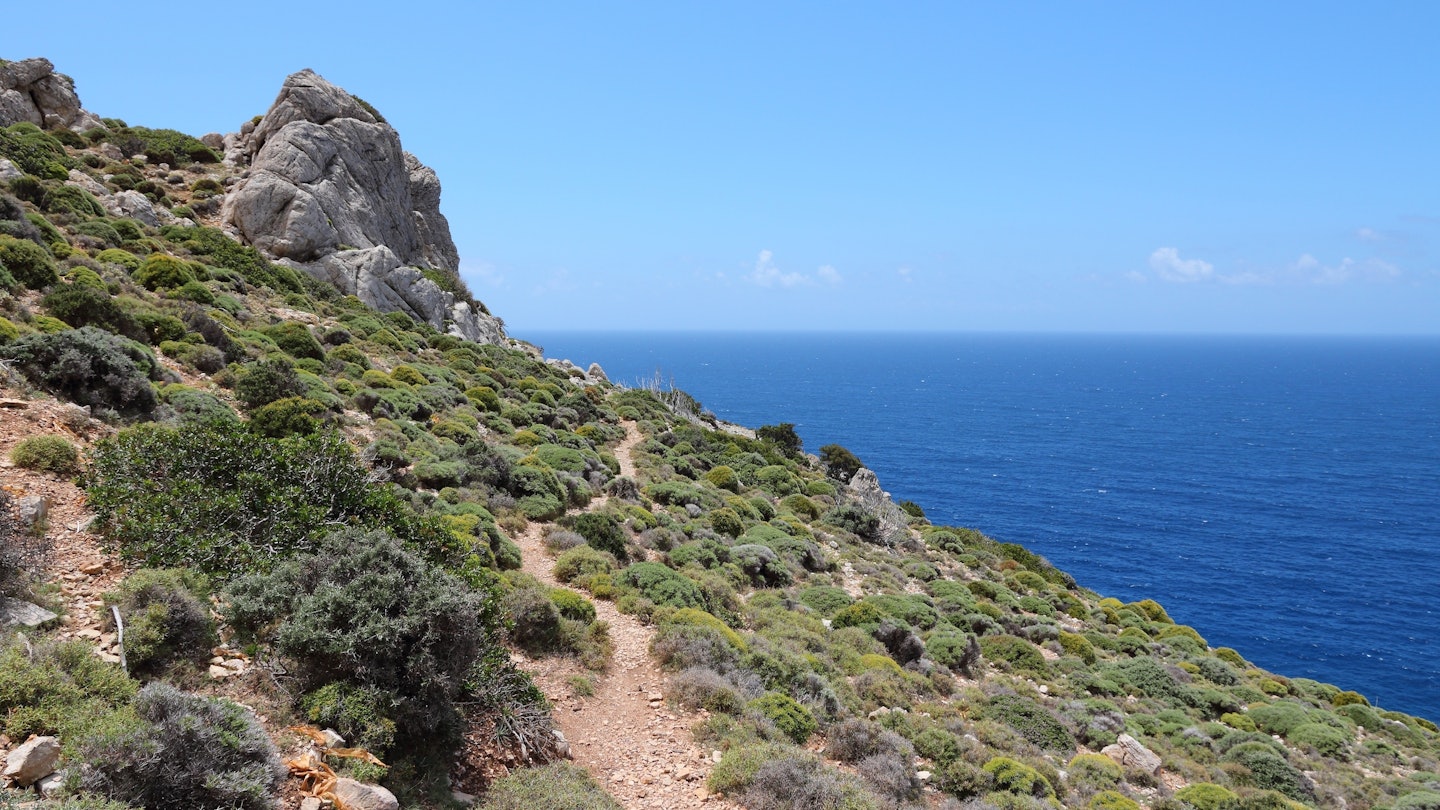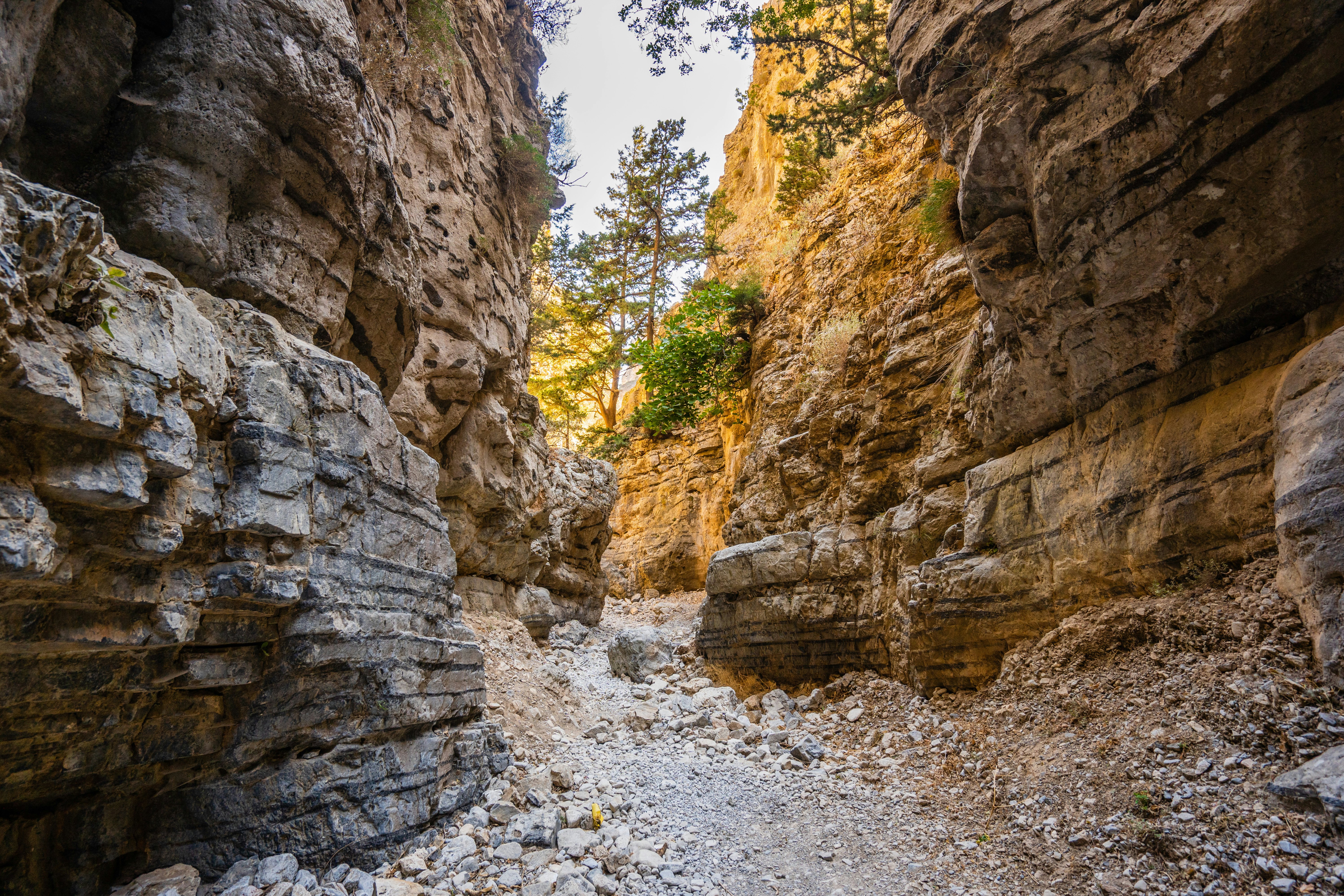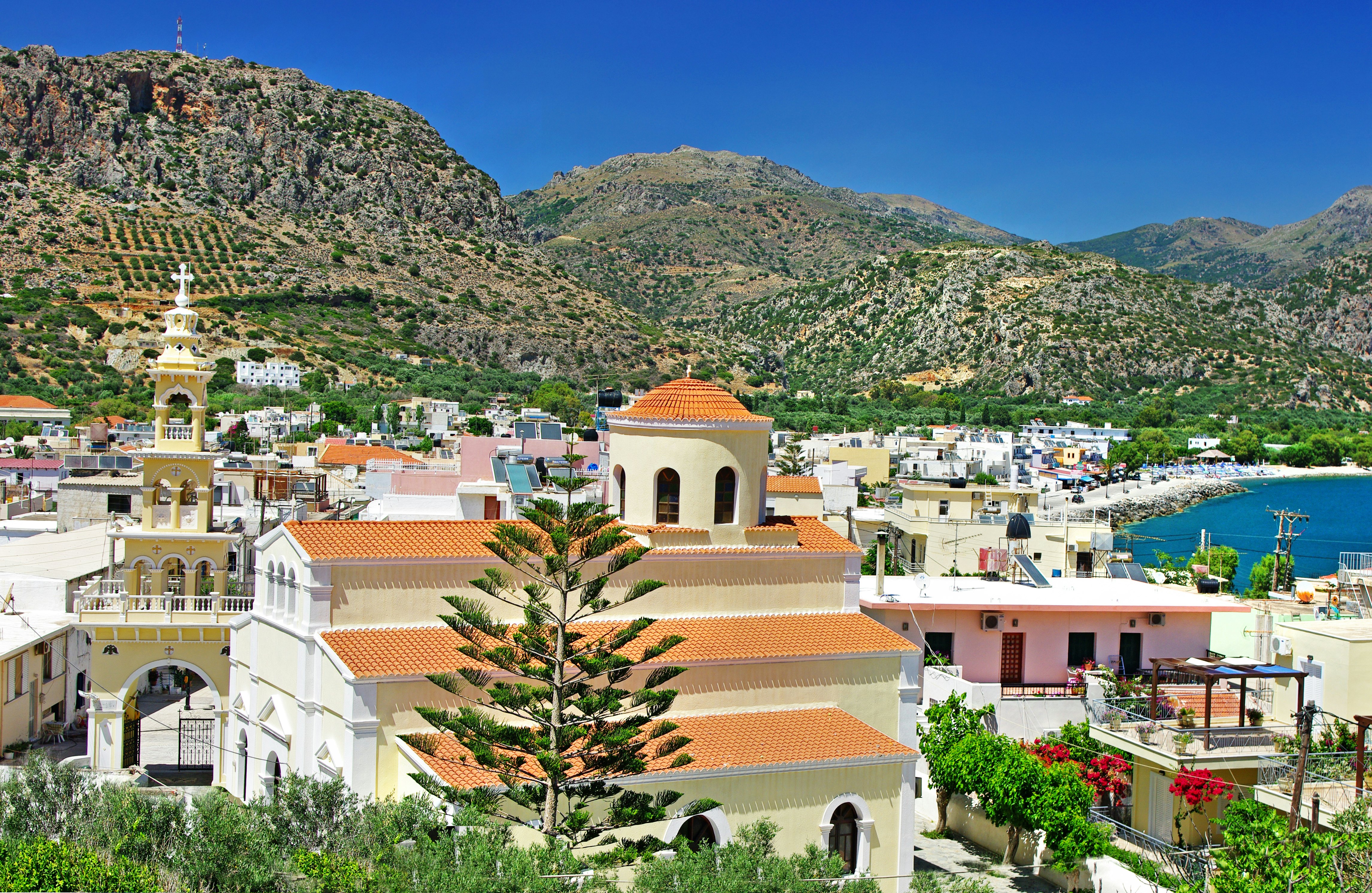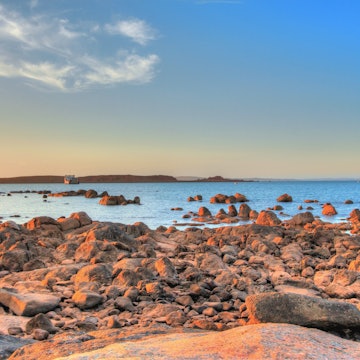

The trail from Elafonisi to Paleochora (Palaiochora). Tupungato/Shutterstock
On the scores of superb hiking trails in Crete, you can glimpse life through the eons. Ancient churches and caves haunted by the ghosts of medieval hermits border paths down deep gorges, into patches of lush foliage and among stark, geological beauty. Most coastal towns also have trails leading to other coastal towns – always ask for options wherever you stay. And for urban walks, the old towns of Hania and Rethymno present superb opportunities to explore enticing lanes, taverna-lined squares, soaring fortresses and piers jutting out into the turquoise sea.
The hike through the Samaria Gorge is the most famous – and crowded – of the island's established treks and is open only a few months per year. Here are five more of our favorite hikes in Crete.

1. Imbros Gorge
Best overall
Distance: 8km (5 miles) one way
Time commitment: 3 hours
Difficulty: moderate
Often compared to the popular Samaria Gorge hike, the walk through Imbros Gorge is just under half the length of Samaria, at 8km (5 miles), yet it still packs in plenty of natural wonders and, most importantly, is much less crowded.
This former mule path used by British troops evacuating Crete in 1941 is bracketed by 300m (984ft) walls lined with fig, almond, cypress and oak trees. At one point the sheer rock faces are only 2m (6.5ft) apart; along the trail, an arch of stone crosses right over the path.
The route begins in the tiny village of Imbros, where markets and cafes have supplies and snacks for your walk. Be sure to bring a lot of water and wear sturdy shoes, since the path has many large and loose stones. The trail starts at 780m (2560ft) above sea level and descends 130m (427ft) to reach Komitades, which also has markets and cafes. From here, you can follow the narrow road 4.6km (2.9 miles) to the fishing village of Hora Sfakion to find a beach, hotels and welcoming tavernas.
Planning tip: Continue your adventure by exploring Crete's southwest coast by sea. Hora Sfakion is a hub for the Anendyk ferries that serve ports such as Loutro, Agia Roumeli (for the Samaria Gorge), Sougia, Paleohora and Gavdos Island.

2. Agiofarango Gorge
Best for an isolated beach
Distance: 7km (4.4 miles) one way
Time commitment: 3 hours
Difficulty: moderate
A hassle-free hike down the gentle slope of a dry river bed, the Agiofarango Gorge trail ends among soaring rock formations at one of southern Crete's most beautiful – and isolated – beaches. The snorkeling is excellent in this sheltered cove.
The trail begins at Moni Odigitrias, a compact and intriguing monastery that has an old defensive tower you can climb for superb views. From April to August the route is awash with color from blooming oleander bushes. Look for moving dots high up on the cliffs – the gorge is a favorite of rock climbers, many of whom camp along the way.
Other highlights include the caves that are ubiquitous in this part of Crete and various abandoned chapels, some dating back almost 1000 years. Far along the route is a Byzantine-era chapel marked by an olive tree and a well that supplies drinking water.
At the beach, you can watch for a boat that can take you to Matala, although there's no guarantee one will come, so you can instead walk back up the trail for 1.5km (0.9 miles) to a small parking area; use your own phone to call a taxi to pick you up.
Planning tip: Besides the well at the monastery, there's no other source of water (or supplies), so bring everything you'll need for the day.

3. Agia Irini Gorge
Best for shade
Distance: 7.5km (4.7 miles) one way
Time commitment: 3 hours
Difficulty: moderate
Lush vegetation and shady trees mark the Agia Irini Gorge hike, which is blissfully unvisited. As you descend, look for small caves in the cliff walls. The air is redolent with the scent of wild herbs for much of the year – just smell the sage in summer! There are many sublime spots where you can enjoy a picnic under a tree with the sound of babbling water.
Descending 500m (1640ft), the trail is unchallenging for most active people, although you will have to clamber over boulders at times. There is plenty of shade along the route, and the path is well maintained. In spring, the river can rise and wash out parts of the trail, which raises the difficulty.
The Agia Irini Gorge is open year-round, and the trail starts just below its namesake village. It concludes at the waterfront village of Sougia, along a sun-drenched but mostly traffic-free road. Taverna Oasis at the end of the trail is a good place for a break, and you can get a taxi from here.
Local tip: Given the myriad spots for a picnic, hit this trail ready to dine. If you're staying in Sougia, any of the many cafes and tavernas can make you a picnic lunch. If you are leaving early, arrange it with them the night before.

4. Aradena Gorge
Best for a remote village
Distance: 3.5km (2.2 miles) one way
Time commitment: 2 hours
Difficulty: moderate
The trail into the Aradena Gorge begins just before the high and rickety Vardinogiannis Bridge, which draws eager bungee jumpers. After less than a kilometer, this uncrowded trail reaches the early Byzantine Church of Agios Ioannis, where the route forks – take the trail to the east and descend through a fairly dense landscape to the idyllic Marmara Beach. This is one of the best and most isolated beaches on the southwest coast and is lapped by waters that are an almost impossibly vibrant teal.
From the beach, a walk of around 4km (2.5 miles) along a scenic and easy coastal trail brings you to the delightful seaside village of Loutro. Here you'll find places to stay, tavernas and a small pebbly beach. It's a fine spot to settle in and enjoy the remote beauty of the coast. There is no road access, but you can catch an Anendyk ferry on the Paleohora–Hora Sfakion route.
At some parts in the gorge, you'll have to scramble over large rocks; at others, you'll find simple metal ladders to get over obstacles. Wear sturdy hiking shoes.
Local tip: If you want to pause and take the 138m (453ft) plunge from the Vardinogiannis Bridge, Liquid Bungy, which runs the show.

5. Paleohora (Palaiochora)–Sougia Coastal Walk
Best coastal trail
Distance: 14.5km (9 miles) one way
Time commitment: 6 hours
Difficulty: moderate
This walk begins in the port town of Paleohora (Palaiochora) and ends in Sougia, following the coastal cliffs for much of its route. The views from the high points take in the coastline, and the trail dips down to several isolated beaches, where clothes are rare but the natural beauty is boundless – perfect for cooling off from your exertions.
For the latter third of the trail, a small pine forest provides scented shade. Some 3.5km (2.2 miles) before Sougia, you'll pass through Lissos, an ancient Greek archeological site with ruins dating from the 2nd century BCE to 900 CE.
Other than the brief respite of the pine trees, the walk has little shade and no sources of water, so bring plenty. Paleohora is easily reached by bus and ferry, and it has good tavernas and accomodations. Sougia is quieter but is also a comfortable place to rest and has ferry and bus connections.
Planning tip: Be sure to add an hour or two to properly appreciate the ruins at Lissos. They are well marked and extensive, plus the setting is magical.
Top tips for hiking in Crete
Having adequate water supplies may seem like a no-brainer, but dehydration is a top cause of injury for people engaging in outdoor activities in Crete during the warmer months. Temperatures regularly top 35°C (95°F), and the sun is relentless. These five hikes are mostly remote and offer few – or no – sources of water along trails. Bring plenty! (Food, too.)
Pack sunscreen, proper sun protection and a full sun hat, for all the reasons listed above.
Wear sturdy hiking shoes or sandals. The trails are uneven and challenging in places. Flip-flops all but guarantee injury.
In remote areas, there may be no phone service, so leave details about your hike with the staff at your lodging and specify who in your group is joining the walk.















